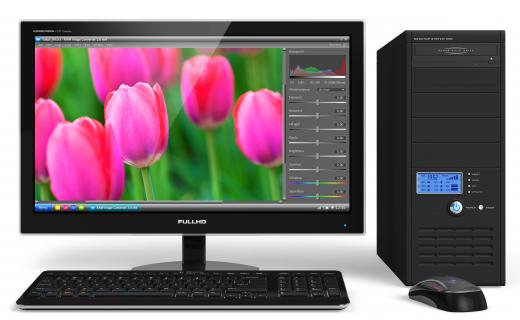At EasyTechJunkie, we're committed to delivering accurate, trustworthy information. Our expert-authored content is rigorously fact-checked and sourced from credible authorities. Discover how we uphold the highest standards in providing you with reliable knowledge.
What Is a Full Computer Tower?
A full computer tower is the largest standard case for desktop personal computers. Full tower cases are used for high-performance machines that require a great deal of internal space to accommodate expansions, advanced cooling systems, and other large hardware items. This size case is also popular among people who build their own computer systems because the larger size makes it easier to assemble or modify a computer’s hardware. These cases, like all tower cases, are oriented vertically.
Tower cases come in a range of sizes, from mini-towers through mid-size towers, up to full computer tower cases. Full-size horizontal computer cases were once the norm for personal computers. Tower cases take up less space, however, and have supplanted horizontal cases.

These cases hold the computer's motherboard, which is positioned vertically along the interior of one side of the case. A power supply is normally housed in the upper portion of the tower, and drive bays are mounted toward the front of the case. Universal serial bus (USB), firewire, Ethernet, and other ports are typically located on both the front and back of the case. A full computer tower will generally have a front power button and various status lights to indicate drive access or power state. Gaming machines are often decorated with ornamental design features or LED lighting to make them look more interesting.

Expansion slots, which allow additional hardware to be added to the computer, are located toward the back of the case. Cards to perform additional functions, such as graphics processing or audio output, are mounted in these slots. Access to the ports on expansion cards is through slots in the rear of a full computer tower, which are normally covered by removable metal plates.

One notable advantage of this type of case is the ease with which new components can be added or removed. All desktop personal computers are designed to be modified or expanded and have parts that can be serviced by a knowledgeable user. Working inside of smaller PC cases can be very challenging, however, and these cases can accommodate only a limited number of expansions. A full computer tower offers much easier access to components because there is room to space them out further from one another.
Heat buildup is an issue in all computer systems. Faster computers and those with additional graphics processors, generate a great deal of heat. A full computer tower is easier to cool than smaller cases. In part, this is because a full computer tower allows components to be spaced out, which reduces heat buildup. These cases can also be modified with more advanced cooling systems, ranging from larger assemblies of fans to liquid-based heat sink systems.
AS FEATURED ON:
AS FEATURED ON:













Discuss this Article
Post your comments